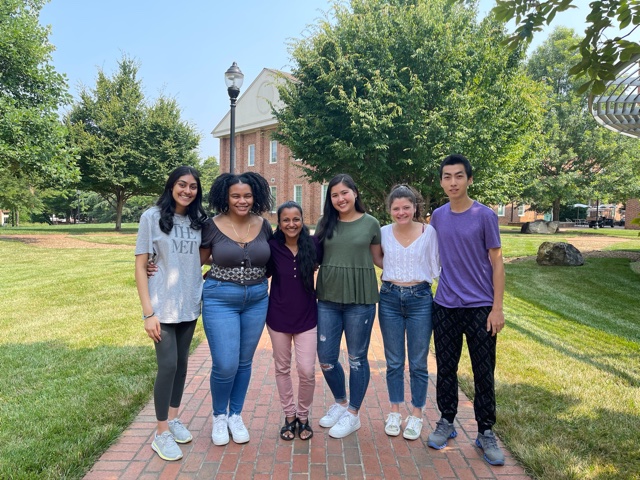By Amanda Cordle, August 2021
Looking around a drugstore, there are rows and rows of different medications and topical ointments. Unfortunately, most pathogens have a certain degree of resistance to these drugs despite scientists and health professionals’ efforts to mitigate this resistance as much as possible.
Furman Biology Professor Dr. Srikripa Chandrasekaran and her research students—Roberta, Neha, Nicole, Amari, Martin, and Dhriti–are studying Cryptococcus neoformans, a pathogenic fungus that can infect individuals who are severely immunocompromised.
“With the available drugs on the market, unfortunately, there is a high incidence of drug resistance in the fungus,” Dr. Chandrasekaran explains, “so, we are studying how stress response mechanisms that the fungi encounter in the host are related to fungal drug resistance.”
Whenever Cryptococcus neoformans infects the human body, the pathogen experiences high levels of stress. The internal temperature of a body is much higher than the normal temperature range in which the fungi live in the wild, and it is also harder for the fungi to receive certain nutrients within the human body.
“The ones that are able to respond effectively to these stresses are the ones that also end up having a high rate of drug resistance,” Dr. Chandrasekaran shares.
In terms of research, the lab is studying which conditions and outside stressors increase or decrease Cryptococcus neoformans resistance to drugs. Each student is focusing on a different condition or stressor that may be creating this resistance.
“My project is looking at the oxidative stress in the host,” shares Roberta, a biology major.
She is studying the effects of oxidative stress on the fungi by injecting Cryptococcus neoformans into worms, which become the host for the fungi. Once the fungus has infected the worm, Roberta gives antioxidants, including vitamins to the worm, which allows her to observe whether vitamins actually help the fungi infecting the host organism to develop drug resistance.
Neha, who is a high school student, is also studying the effects of oxidative stress within Cryptococcus neoformans cells.
“I tested different antioxidants that relieve the oxidative stress in the fungi,” Neha states. “I tested them on media infused with multiple natural anti-oxidants to see if the fungus would grow or not.”
Based on the results of this test, doctors will know which antioxidants to advise patients struggling with a Cryptococcus infection to avoid because eating antioxidants that facilitated fungal growth in the experiment would do the same in the host’s body.
In addition to the role of oxidative stress and antioxidants in the proliferation of the fungi, Dr. Chandrasekaran’s lab is also studying the effects of gene expression in Cryptococcus.
Nicole, who is also a biology major, is researching the Swe 1 protein in Cryptococcus neoformans. This protein plays a role in the cell cycle checkpoint regulation and helps cells mitigate DNA damage response. More specifically, she is studying how DNA damaging drugs affect Cryptococcus in the absence of Swe 1 protein. She believes that the ability to tolerate DNA damage is linked to anti-fungal drug resistance and her research implies the involvement of Swe 1 protein in drug resistance.
“I have six different strains of the Cryptococcus, and they each have different mutations of the Swe 1 protein, so I’m testing how these drugs influence the growth of these strains,” Nicole explains.
One of her main research questions is if exposing the fungi to DNA stressors prior to administering the medication increases the likelihood of drug resistance.
In other words, “Does previous stress allow it [the fungi] to overcome future stress,” Nicole says.
In addition, Amari is running an RNA transcriptional analysis of the fungi.
“My research is looking at the molecular mechanisms that fuel antifungal drug resistance in Cryptococcus,” she explains. “At the beginning of the summer I did RNA sequencing on Cryptococcus cells treated with fluconazole [antifungal medicine] and antioxidants, and right now we’re waiting for those results to come back.”
These results will enable Amari to see which genes Cryptococcus neoformans upregulates because of the treatments and could therefore be contributing to high rates of drug resistance.
The last two researchers in Dr. Chandrasekaran’s lab have taken slightly different approaches than their peers in their studies of drug resistance in the Cryptococcus neoformans.
Instead of focusing only on the pathogenic fungus, Cryptococcus, Martin is also studying the fungi Saccharomyces cerevisiae, otherwise known as baker’s yeast. Cryptococcus and Saccharomyces are both yeast, but only Cryptococcus is pathogenetic. Martin is comparing the effect of antioxidants on a pathogenic fungus v/s a non-pathogenic fungus.
“I am focusing on five different genes and studying whether they are expressed or suppressed after the drugs [antioxidants and fluconazole] are applied,” Martin explains.
The overall goal behind this study is to learn what makes Cryptococcus neoformans infectious by comparing it to a similar, but non-infectious, yeast.
Finally, Dhriti’s research also branches away from the other projects in the lab. Although
Dhriti was absent for the interview, Dr. Chandrasekaran still discussed her research. Dhriti is focusing on the effect that heat stress has on Cryptococcus neoformans.
Although Dr. Chandrasekaran’s lab is conducting many experiments this summer, she foresees that her research on drug resistance with Cryptococcus neoformans will last at least a decade, if not two. There are many questions that still must be answered, many of which researchers cannot study without gaining insight from preliminary studies, such as those being conducted this summer.
For instance, the results from Amari’s transcriptional analysis will provide more information for Dr. Chandrasekaran and her students to study several genes linked to drug resistance in the future.
“Amari’s transcription analysis is fishing for all the genes that are upregulated or expressed in high numbers in response to fluconazole or fluconazole and antioxidants. Then, once we have those candidates, we can pursue each of them, and each can be a separate project in itself,” explains Dr. Chandrasekaran.
Amari’s research as well as the other projects in Dr. Chandrasekaran’s lab are only the beginning of the quest to understand Cryptococcus neoformans’ resistance to drugs.
